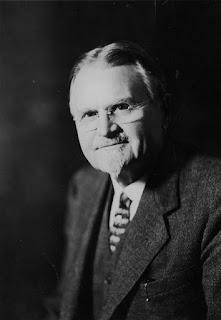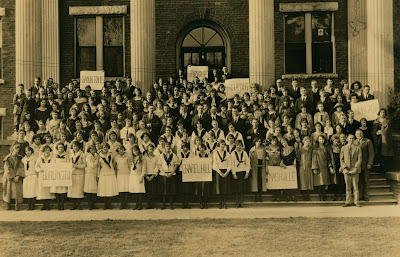Over the next two weeks, UNCG will play host to hundreds of students attending Summer Music Camp. The Summer Music Camp, which began in 1983, has grown to be the largest university music camp in America. In two one-week sessions, students are instructed in band, mixed chorus, orchestra, and piano. But the Summer Music Camp is not the first program for younger students on the UNCG campus. On Friday, May 7, 1920, thirteen pianists from high schools across North Carolina arrived on campus (which was then known as the North Carolina College for Women) to compete in the first musical contest for students ever to be held in the state.
The North Carolina State High School Music Contest-Festival was the brainchild of Wade R. Brown, who had begun his work on campus as the Director of the Department of Music in 1912. During this period, music was not part of the standard curriculum in secondary schools in North Carolina. Rarely were music teachers employed in public schools, and, when they were, this was typically only to teach private piano lessons in a designated classroom. As Brown wrote, “in our own state (and over most of the South) our educational leaders and the public as a whole seemed indifferent to the cultural value of music in education and to the final contribution it had to offer in a social democracy such as ours.”
In hopes of improving this situation, in 1919, Brown decided to attempt to organize a music contest aimed at high school students in North Carolina. Due to the fact that piano performance was the only type of music taught in public schools at that time, they determined to focus the contest on that instrument alone. With the blessings of President Julius Foust, Brown wrote a letter to high school principals and piano teachers across the state announcing that this piano contest for high school students would be held at the North Carolina College for Women on May 7, 1920. Each school was invited to send one pianist to represent them in the contest.
Brown turned the competition into a weekend-long event. Competitors and their teachers were invited to be guests at a performance by E. Robert Schmitt, a celebrated French pianist. On the day of the contest, they were treated to another special piano performance by one of the members of the senior class at NCCW.
While fourteen student enrolled in the competition, only thirteen appeared on the day of the contest. Beginning at 10:30am, each student performed a solo piece before a panel of three judges. The judges were faculty members from Salem College, Greensboro College, and NCCW. From among the thirteen, those judges selected six to play again that evening at 8:00pm in the finals. The contest drew a large number of students, visiting teachers, and the general public to observe the final competition. After the six finalist performed, the audience was entertained by “an informal program of community singing” and a short lecture on the importance of music education while the judges conferred.
In the end, the judges selected Jessie Mercer of the Wilmington High School as the winner of the first contest. She was awarded “the silver loving cup, given by the Euterpe Club of Greensboro, which was to remain in her possession until the next State Contest.”
The state contest continued to grow over the years. In 1922, competitions for glee clubs and violin soloists joined the piano contests. Orchestra competitions were added in 1925. Additional contests for strings (1927), woodwinds (1928), and brass (1928) also appeared. By 1929, the contest had grown so popular that students were divided into classifications based on the enrollment of their high school. Additionally, students in smaller high schools (those with enrollments under 500 had to survive a “District Elimination Contest” prior to traveling to Greensboro.
Ultimately, these contests also helped impact the music education curriculum in North Carolina secondary schools. As Brown noted in his introduction to the 1946 pamphlet The State Music Contest-Festival: A History, “these great annual gatherings … have done so much to make a real beginning in musical appreciation and artistic development among the youth of North Carolina.”
By Erin Lawrimore


